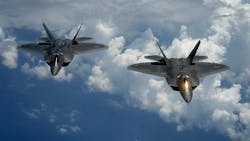Air Force reaches out to industry for terahertz air-to-air communications to share situational awareness
ROME, N.Y. – U.S. Air Force researchers are asking industry for enabling technologies for future line-of-sight air-to-air communications and networking at frequencies higher than 100 GHz to help aircraft exchange mission-critical battle-management information.
Officials of the Air Force Research Laboratory Information Directorate in Rome, N.Y., issued a broad agency announcement (FA875018S7016) on Monday for the Terahertz Communications project.
The aim is to develop and demonstrate an interoperable, modular, and sustainable network fabric to relay intelligence, surveillance, and reconnaissance (ISR) sensor data for shared situational awareness and command & control (C2).
The goal is to develop capabilities that help shape future Air Force communications solutions. Air Force experts will test proposed terahertz communications technologies through modeling and simulation.
The project has two focus areas: propagation modeling, channel testing, and link budget analysis above 100 GHz; and network strategies to optimize the use of RF spectra above 100 GHz.
Propagation modeling, channel testing, and link budget analysis above 100 GHz seeks to show experts how atmospheric propagation characteristics change based on the atmospheric pressure, humidity, and altitude at a given point in space. Understanding the tradeoffs between these conditions could help the Air Force deploy new communications capabilities.
Researchers want contractors to analyze physics-based propagation models to understand the gaps and limitations of current communications; develop statistical modeling of reflection, scattering, and blocking due to various weather events and mobility of the system; develop and test RF channel sounding equipment to determine signal losses across distances of as far as 250 miles; and develop statistical channel models to close the gap in predicted performance in airborne scenarios.
Network strategies to optimize the use of RF spectra above 100 GHz, meanwhile, seeks to use RF properties in these frequencies like high propagation loss and high amounts of directivity to optimize networks by enabling frequency reuse.
The focus is to develop networking solutions that take advantage of the super-high bandwidth from recent developments in high frequency bands. Challenges include very high path loss, directional beams, and beam blockage.
Areas of interest include use of dynamic electronically steerable multiple-input and multiple-output (MIMO) arrays for dynamic beamforming, beam tracking, and alternate path finding in case of beam blockage; active and passive relaying and multi-hop communication schemes; in-band and out-of-band link layer protocols; and synchronization and medium access strategies that consider the effect of very high-speed data rates in high-speed airborne networks.
Researchers also are interested in transport and network layer protocols that can support very high data-arrival rates without data loss or queueing issues; and compatibility with legacy frequency band access.
The Air Force has about $10 million to spend over the four-year project. From industry the Air Force is asking for white papers, and those submitting promising ideas will be invited to submit full proposals.
Companies interested should email unclassified white papers by 20 Sept. 2020 to the Air Force's Rober DiMeo at [email protected].
Email technical questions or concerns to Rober DiMeo at [email protected]. Email business or contactual questions or concerns to Gail Marsh at [email protected].
More information is online at https://beta.sam.gov/opp/6cf663832f674237b348ef70d10bc6f8/view.
About the Author
John Keller
Editor-in-Chief
John Keller is the Editor-in-Chief, Military & Aerospace Electronics Magazine--provides extensive coverage and analysis of enabling electronics and optoelectronic technologies in military, space and commercial aviation applications. John has been a member of the Military & Aerospace Electronics staff since 1989 and chief editor since 1995.
